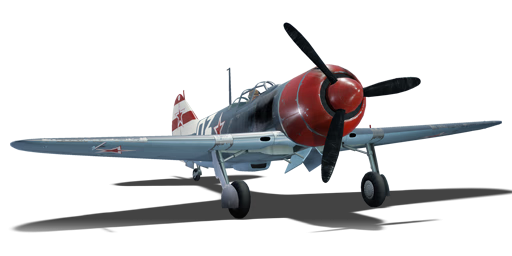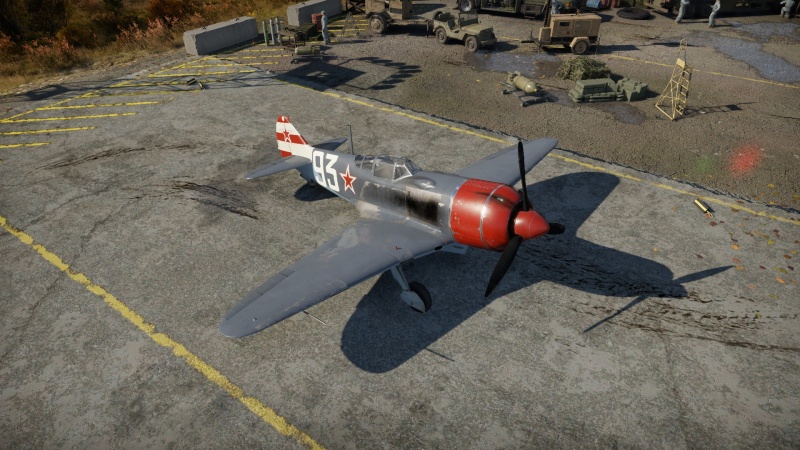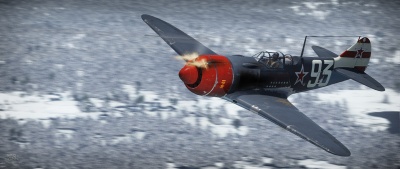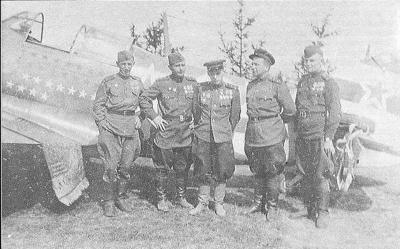Difference between revisions of "Dolgushin's La-7"
m (Added store removal, and reappearance) |
Colok76286 (talk | contribs) (Edits) |
||
| (5 intermediate revisions by 4 users not shown) | |||
| Line 11: | Line 11: | ||
== Description == | == Description == | ||
<!-- ''In the description, the first part should be about the history of and the creation and combat usage of the aircraft, as well as its key features. In the second part, tell the reader about the aircraft in the game. Insert a screenshot of the vehicle, so that if the novice player does not remember the vehicle by name, he will immediately understand what kind of vehicle the article is talking about.'' --> | <!-- ''In the description, the first part should be about the history of and the creation and combat usage of the aircraft, as well as its key features. In the second part, tell the reader about the aircraft in the game. Insert a screenshot of the vehicle, so that if the novice player does not remember the vehicle by name, he will immediately understand what kind of vehicle the article is talking about.'' --> | ||
| − | '''{{Specs|name}}''' | + | '''{{Specs|name}}''' was a Soviet fighter aircraft, belonging to Sergei Fjodorovich Dolgushin, a Soviet WWII fighter ace with 15 victories solo and another 8 shared, and also a recipient of Hero of the Soviet Union award. Dolgushin was born on 25 September 1920 in Novopokrovskoje, Tulsa Oblast and joined the Red Army in 1937 to study on Kachin Military Aviation Pilot School where he graduated in 1940 in the same course as Vasily Stalin, Joseph Stalin's youngest son. Dolgushin scored his first two kills on 22 June 1941 when two German planes violated the Soviet border. In May 1942, he was awarded Hero of the Soviet Union for exemplary performance of combat missions of the command on the front of the fight against the German invaders and the courage and heroism shown at the same time. In January 1943, Dolgushin was appointed squadron commander of the 32th GIAP while the regiment was commanded by Vasily Stalin. In September 1943, Dolgushin was appointed commander of the 156th IAP which he commanded until the fall of 1946. He continued to serve in the army until leaving in 1979. Dolgushin died on 29 June 2011 in Moscow. |
| − | + | Dolgushin's La-7 was introduced as a [[wt:en/news/3071--en|premium pack]] in [[Update 1.49 "Weapons of Victory"]]. It was discontinued after the [[wt:en/news/4684-vday-victory-day-discounts-en/|2017 Victory Day sales]] and has since been made available briefly for purchase in the store on occasion, such as the [[wt:en/news/4527-shop-special-discounts-en|2017 "Special Discounts!"]], the [[wt:en/news/6170-special-victory-day-en|2019 Victory Day]] and the [[wt:en/news/7154-shop-may-sale-in-the-gaijin-store-en|2021 May]] sales. The plane is painted after the camouflage scheme of Soviet pilot Sergei F. Dolgushin in the 156th fighter aviation regiment from September 1944 onward. The playstyle and flight performance of the Dolgushin's La-7 are essentially the same as its tech tree counterpart. | |
== General info == | == General info == | ||
| Line 108: | Line 108: | ||
== Usage in battles == | == Usage in battles == | ||
| − | ''Describe the tactics of playing in the aircraft, the features of using aircraft in a team and advice on tactics. Refrain from creating a "guide" - do not impose a single point of view, but instead, give the reader food for thought. Examine the most dangerous enemies and give recommendations on fighting them. If necessary, note the specifics of the game in different modes (AB, RB, SB).'' | + | <!-- ''Describe the tactics of playing in the aircraft, the features of using aircraft in a team and advice on tactics. Refrain from creating a "guide" - do not impose a single point of view, but instead, give the reader food for thought. Examine the most dangerous enemies and give recommendations on fighting them. If necessary, note the specifics of the game in different modes (AB, RB, SB).'' --> |
[[File:FighterImage_La7ShVAKbig.jpg|thumb|400px|right|Dolgushin's La-7.]] | [[File:FighterImage_La7ShVAKbig.jpg|thumb|400px|right|Dolgushin's La-7.]] | ||
| + | The key to staying alive in the La-7 lies in deceiving the enemy. By flying at around 4.5 km altitude you present yourself as an easy target for Boom & Zoom aircraft that are flying at higher altitudes. When you spot someone diving at you, break off and evade his burst, while slowly luring him into manoeuvre combat - this way you will start gaining the edge while the enemy loses his speed and momentum in the turn. Another habit worth developing in the La-7 is ammo conservation - the ShVAK shoot fast and in RB it is a skill worth having - it is crucial to only take shots that you know will hit and aiming them carefully. This way you stand a bigger chance of critically damaging the enemy airplane. By following those rules you will soon find yourself researching the final Lavochkin piston fighter - the [[La-9]]. | ||
====Tactics==== | ====Tactics==== | ||
| Line 164: | Line 165: | ||
In September 1944, the first La-7s found their way onto the front lines with the 63rd Guard Fighter Aviation Corps. The reception of the new fighter was warm - it was faster and more manoeuvrable than the La-5, which meant it could more efficiently tackle the most common German fighter the Soviets faced: the Messerschmitt Bf 109 G. In certain circumstances, the speed allowed the Soviet pilots to intercept Fw 190 fighter-bombers - a feat impossible to achieve for other Soviet fighters like the Yak-3. The main critiques of the design were considered to be the engine reliability and armament - the twin 20 mm ShVAK cannons were judged as inadequate in fights against better-armoured Fw190s. Still, the La-7 became one of the most successful Soviet piston fighters of World War II. Soviet ace Ivan Kozhedub scored 17 kills while flying the La-7 - his last one being an [[Me_262_A-1a|Me 262]] jet. After the war, the La-7 was replaced by the La-9 prop fighter, although many were still used by other communist states as both fighters and trainer aircraft. | In September 1944, the first La-7s found their way onto the front lines with the 63rd Guard Fighter Aviation Corps. The reception of the new fighter was warm - it was faster and more manoeuvrable than the La-5, which meant it could more efficiently tackle the most common German fighter the Soviets faced: the Messerschmitt Bf 109 G. In certain circumstances, the speed allowed the Soviet pilots to intercept Fw 190 fighter-bombers - a feat impossible to achieve for other Soviet fighters like the Yak-3. The main critiques of the design were considered to be the engine reliability and armament - the twin 20 mm ShVAK cannons were judged as inadequate in fights against better-armoured Fw190s. Still, the La-7 became one of the most successful Soviet piston fighters of World War II. Soviet ace Ivan Kozhedub scored 17 kills while flying the La-7 - his last one being an [[Me_262_A-1a|Me 262]] jet. After the war, the La-7 was replaced by the La-9 prop fighter, although many were still used by other communist states as both fighters and trainer aircraft. | ||
| − | |||
| − | |||
| − | |||
| − | |||
| − | |||
== Media == | == Media == | ||
| Line 174: | Line 170: | ||
;Skins | ;Skins | ||
| − | * [https://live.warthunder.com/feed/camouflages/? | + | * [https://live.warthunder.com/feed/camouflages/?vehicle=la-7_dolgushin Skins and camouflages for the {{PAGENAME}} from live.warthunder.com.] |
;Images | ;Images | ||
Latest revision as of 03:41, 27 January 2024
| This page is about the premium Soviet fighter Dolgushin's La-7. For other versions, see La-7 (Family). |
Contents
Description
Dolgushin's La-7 was a Soviet fighter aircraft, belonging to Sergei Fjodorovich Dolgushin, a Soviet WWII fighter ace with 15 victories solo and another 8 shared, and also a recipient of Hero of the Soviet Union award. Dolgushin was born on 25 September 1920 in Novopokrovskoje, Tulsa Oblast and joined the Red Army in 1937 to study on Kachin Military Aviation Pilot School where he graduated in 1940 in the same course as Vasily Stalin, Joseph Stalin's youngest son. Dolgushin scored his first two kills on 22 June 1941 when two German planes violated the Soviet border. In May 1942, he was awarded Hero of the Soviet Union for exemplary performance of combat missions of the command on the front of the fight against the German invaders and the courage and heroism shown at the same time. In January 1943, Dolgushin was appointed squadron commander of the 32th GIAP while the regiment was commanded by Vasily Stalin. In September 1943, Dolgushin was appointed commander of the 156th IAP which he commanded until the fall of 1946. He continued to serve in the army until leaving in 1979. Dolgushin died on 29 June 2011 in Moscow.
Dolgushin's La-7 was introduced as a premium pack in Update 1.49 "Weapons of Victory". It was discontinued after the 2017 Victory Day sales and has since been made available briefly for purchase in the store on occasion, such as the 2017 "Special Discounts!", the 2019 Victory Day and the 2021 May sales. The plane is painted after the camouflage scheme of Soviet pilot Sergei F. Dolgushin in the 156th fighter aviation regiment from September 1944 onward. The playstyle and flight performance of the Dolgushin's La-7 are essentially the same as its tech tree counterpart.
General info
Flight performance
| Characteristics | Max Speed (km/h at 6,250 m) |
Max altitude (metres) |
Turn time (seconds) |
Rate of climb (metres/second) |
Take-off run (metres) | |||
|---|---|---|---|---|---|---|---|---|
| AB | RB | AB | RB | AB | RB | |||
| Stock | 650 | 627 | 10450 | 20.0 | 20.7 | 14.0 | 14.0 | 348 |
| Upgraded | 714 | 676 | 18.3 | 19.2 | 23.9 | 18.2 | ||
Details
| Features | ||||
|---|---|---|---|---|
| Combat flaps | Take-off flaps | Landing flaps | Air brakes | Arrestor gear |
| ✓ | ✓ | ✓ | X | X |
| Limits | ||||||
|---|---|---|---|---|---|---|
| Wings (km/h) | Gear (km/h) | Flaps (km/h) | Max Static G | |||
| Combat | Take-off | Landing | + | - | ||
| 735 | 320 | 504 | 471 | 300 | ~13 | ~13 |
| Optimal velocities (km/h) | |||
|---|---|---|---|
| Ailerons | Rudder | Elevators | Radiator |
| < 350 | < 350 | < 440 | > 230 |
Survivability and armour
- 55 mm Bulletproof glass in cockpit front
- 66 mm Bulletproof glass in cockpit rear (Can be upgraded to 75 mm with Armored glass modification)
- 8.5 mm Steel plate behind the pilot (Can be upgraded to 10 mm with Rear armor plate modification)
Modifications and economy
Armaments
Offensive armament
Dolgushin's La-7 is armed with:
- 2 x 20 mm ShVAK cannons, nose mounted (170 rpg = 340 total)
Suspended armament
Dolgushin's La-7 can be outfitted with the following ordnance:
- Without load
- 2 x 50 kg FAB-50sv bombs (100 kg total)
- 2 x 100 kg FAB-100sv bombs (200 kg total)
Usage in battles
The key to staying alive in the La-7 lies in deceiving the enemy. By flying at around 4.5 km altitude you present yourself as an easy target for Boom & Zoom aircraft that are flying at higher altitudes. When you spot someone diving at you, break off and evade his burst, while slowly luring him into manoeuvre combat - this way you will start gaining the edge while the enemy loses his speed and momentum in the turn. Another habit worth developing in the La-7 is ammo conservation - the ShVAK shoot fast and in RB it is a skill worth having - it is crucial to only take shots that you know will hit and aiming them carefully. This way you stand a bigger chance of critically damaging the enemy airplane. By following those rules you will soon find yourself researching the final Lavochkin piston fighter - the La-9.
Tactics
The strengths of all La-7 variants lie in very good low altitude performance - ideally, you want to engage your enemies at altitudes lower than 5 km - higher up, the power output of the engine reduces drastically, making you an easy target. Aside from the speed, the La-7 possesses very good turning capabilities - while it is not as good a turner as some British and Japanese designs, it can give many German and US aircraft a run for their money.
Manual Engine Control
| MEC elements | ||||||
|---|---|---|---|---|---|---|
| Mixer | Pitch | Radiator | Supercharger | Turbocharger | ||
| Oil | Water | Type | ||||
| Not controllable | Controllable Not auto controlled |
Controllable Not auto controlled |
Controllable Not auto controlled |
Separate | Controllable 2 gears |
Not controllable |
Pros and cons
Pros:
- Excellent low altitude performance (< 3,000 m/9,843 ft)
- Decent manoeuvrability
- Great acceleration and climb
- Good roll rate
- Centre-mounted cannons
- Decent visibility
- Good speed in level flight
- Bomb options
Cons:
- Poor performance at high altitude (> 4,000 m/13,124 ft)
- Poor maximum dive speed
- Fast-firing cannons mean less fire time
- Tends to bleed energy
- Center-mounted cannons can be difficult to master
- Relatively poor durability- wings tend to rip at higher speeds compared to contemporaries
History
The concept of a new fighter for the Soviet Air Force was pitched in 1943. While the earlier Lavochkin La-5 proved to be one of the best Soviet fighters produced up to that point, the main designer of the La-5, Semyon Lavochkin, felt that it could be improved even further. Work on a completely new fighter began in the early months of 1944. The new fighter was supposed to be an improved version of the La-5 design. The changes included the incorporation of a lighter and more durable metal airframe in place of the earlier wooden one. Other changes included the mounting of a new gun sight and propeller, as well as the strengthening of the landing gear struts and streamlining of the wings. It was to be armed with three Berezin B-20 20 mm cannons, however, the delay in production meant that most new La-7s were armed with 2 x 20 mm ShVAK cannons, like its predecessor. After more tests, the new fighter was accepted into serial production in late 1944.
In September 1944, the first La-7s found their way onto the front lines with the 63rd Guard Fighter Aviation Corps. The reception of the new fighter was warm - it was faster and more manoeuvrable than the La-5, which meant it could more efficiently tackle the most common German fighter the Soviets faced: the Messerschmitt Bf 109 G. In certain circumstances, the speed allowed the Soviet pilots to intercept Fw 190 fighter-bombers - a feat impossible to achieve for other Soviet fighters like the Yak-3. The main critiques of the design were considered to be the engine reliability and armament - the twin 20 mm ShVAK cannons were judged as inadequate in fights against better-armoured Fw190s. Still, the La-7 became one of the most successful Soviet piston fighters of World War II. Soviet ace Ivan Kozhedub scored 17 kills while flying the La-7 - his last one being an Me 262 jet. After the war, the La-7 was replaced by the La-9 prop fighter, although many were still used by other communist states as both fighters and trainer aircraft.
Media
- Skins
- Images
An artist's rendering of Dolgushin's La-7 fighter
- Videos
See also
Links to the articles on the War Thunder Wiki that you think will be useful for the reader, for example:
- reference to the series of the aircraft;
- links to approximate analogues of other nations and research trees.
External links
| Lavochkin Design Bureau (Лавочкинa Опытное конструкторское бюро) | |
|---|---|
| LaGG-3* | I-301 · LaGG-3-4 · LaGG-3-8 · LaGG-3-11 · LaGG-3-23 · LaGG-3-34 · LaGG-3-35 · LaGG-3-66 |
| La-5/7 | La-5 · La-5F · La-5FN · La-7 · Dolgushin's La-7 · La-7B-20 |
| La-9/11 | La-9 · La-11 |
| Jet Fighters | La-15 · La-174 · La-200 |
| Export | ␗La-9 · ␗La-11 |
| Captured | ▀La-5FN |
| *Lavochkin-Gorbunov-Gudkov (Лавочкин-Горбунов-Гудков), head designer V. P. Gorbunov | |
| USSR fighters | |
|---|---|
| I-15 | I-15 WR · I-15 M-22 · I-15 M-25 · I-15bis · Krasnolutsky's I-15bis |
| I-153 M-62 · Zhukovsky's I-153-M62 · I-153P | |
| I-16 | I-16 type 5 · I-16 type 10 · I-16 type 18 · I-16 type 24 · I-16 type 27 · I-16 type 28 · I-180S |
| I-29 | I-29 |
| I-185 | I-185 (M-71) · I-185 (M-82) |
| I-225 | I-225 |
| ITP | ITP (M-1) |
| MiG-3 | MiG-3-15 · MiG-3-15 (BK) · MiG-3-34 |
| LaGG | I-301 · LaGG-3-4 · LaGG-3-8 · LaGG-3-11 · LaGG-3-23 · LaGG-3-34 · LaGG-3-35 · LaGG-3-66 |
| La | La-5 · La-5F · La-5FN · La-7 · Dolgushin's La-7 · La-7B-20 · La-9 · La-11 |
| Yak-1/7 | Yak-1 · Yak-1B · Yak-7B |
| Yak-3 | Yak-3 · Eremin's Yak-3(e) · Yak-3P · Yak-3T · Yak-3U · Yak-3 (VK-107) |
| Yak-9 | Yak-9 · Yak-9B · Golovachev's Yak-9M · Yak-9T · Yak-9K · Yak-9U · Yak-9UT · Yak-9P |
| Other countries | ▂P-40E-1 · ▂P-47D-27 · ▂Hurricane Mk IIB · ▂Fw 190 D-9 · ▂Spitfire Mk IXc |
| P-39 | ▂P-39K-1 · ▂Pokryshkin's P-39N-0 · ▂P-39Q-15 |
| P-63 | ▂P-63A-5 · ▂P-63A-10 · ▂P-63C-5 |
| USSR premium aircraft | |
|---|---|
| Fighters | Krasnolutsky's I-15bis · I-16 type 28 · Zhukovsky's I-153-M62 · I-153P · I-180S · I-301 · ITP (M-1) |
| LaGG-3-4 · LaGG-3-23 · LaGG-3-34 · Dolgushin's La-7 · La-11 | |
| Eremin's Yak-3(e) · Yak-3 (VK-107) · Yak-3T · Golovachev's Yak-9M | |
| ▂P-39K-1 · ▂Pokryshkin's P-39N-0 · ▂P-39Q-15 · ▂P-40E-1 · ▂P-47D-27 · ▂P-63A-5 · ▂P-63A-10 · ▂P-63C-5 | |
| ▂Hurricane Mk IIB · ▂Spitfire Mk IXc · ▂Fw 190 D-9 | |
| Twin-engine fighters | I-29 |
| Jet fighters | Su-11 · MiG-15bis ISh · MiG-17AS · MiG-21S (R-13-300) · MiG-23ML |
| Strike aircraft | IL-2M "Avenger" · IL-2 M-82 · IL-8 (1944) · Su-6 · Tandem MAI · TIS MA · Su-8 · Tu-1 |
| Yak-38 · Su-7BMK · Su-25K · Su-39 | |
| Bombers | Po-2M · Be-6 · MBR-2-M-34 · Pe-2-205 · TB-3M-17-32 |
| ▂PBY-5A Catalina · ▂Hampden TB Mk I · ▂A-20G-30 · ▂B-25J-30 | |








